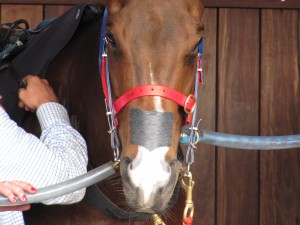My web site administrator has been exhorting me to provide more information, more lessons on what budding horse watchers should look out for. Less colour and movement. More nitty gritty.
So, here beginneth today’s lesson.
The nasal strip. It’s pretty hard to miss if you simply look at the nose of a horse, but is still quite rare on Melbourne’s race tracks. There was one at Flemington today on Uncle Ivan in the seventh race.
Nasal strips have only been added to the list of nationally approved gear since 1st April last year. They must be of a design and specification approved by the stewards, with only one currently approved brand, the “Flair” nasal strip. Their method of action is much like the strips used by human athletes – to provide increased air flow through the nasal passage. In the horse the strips support the soft tissues over the nasal passage which helps to reduce airway resistance during exercise. The Flair website has a good Youtube video on how to stick them on.
The equine exercise physiologists have had a look at them and a study by SJ Holcombe and colleagues in the American Journal of Veterinary Research concluded that: “The commercially available nasal strip tented the skin over the nasal valve and dilated that section of the nasal passage, resulting in decreased airway resistance during inspiration. The nasal strip probably decreases the amount of work required for respiratory muscles in horses during intense exercise and may reduce the energy required for breathing in these horses.”
Do they work? A quick check of my database for the last few months shows that I have been to 20 race meetings since 1st January and looked at 1675 horses. I noticed six horses using nasal strips on 11 occasions, for one win and five placings, including Uncle Ivan, who finished third. So, more than 50% strike rate for the place! Not bad! Maybe I should put a watch on them. My usual view on gear of any sort is that the horse has a problem which the trainer is trying to correct. So I much prefer cleanskins. But I’ll keep an open mind on nasal strips until I have more data. At the current rate I should have seen enough horses – 100 is a minimum sample size – by 2014.
Here endeth the lesson.



